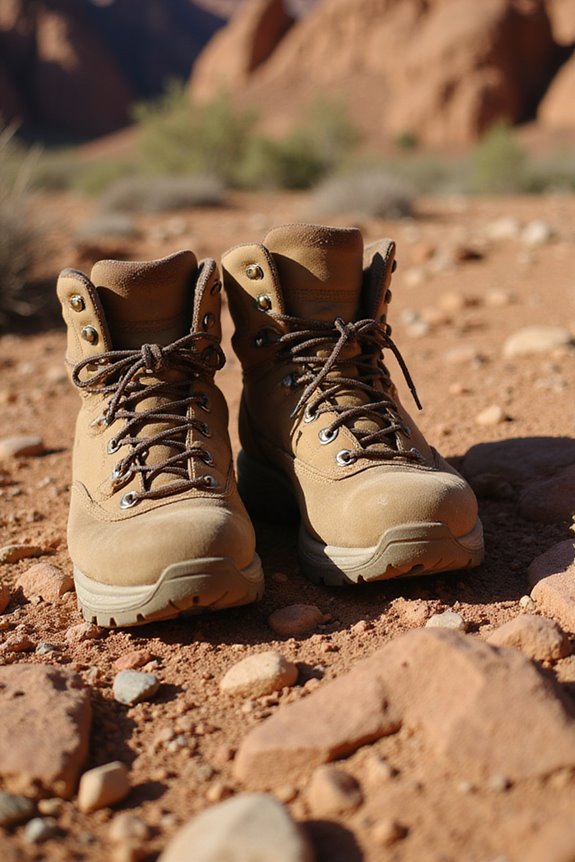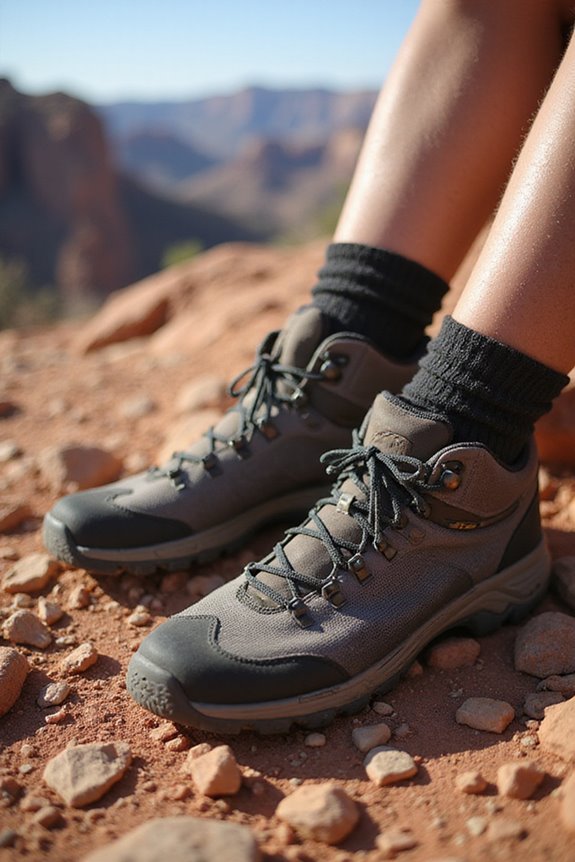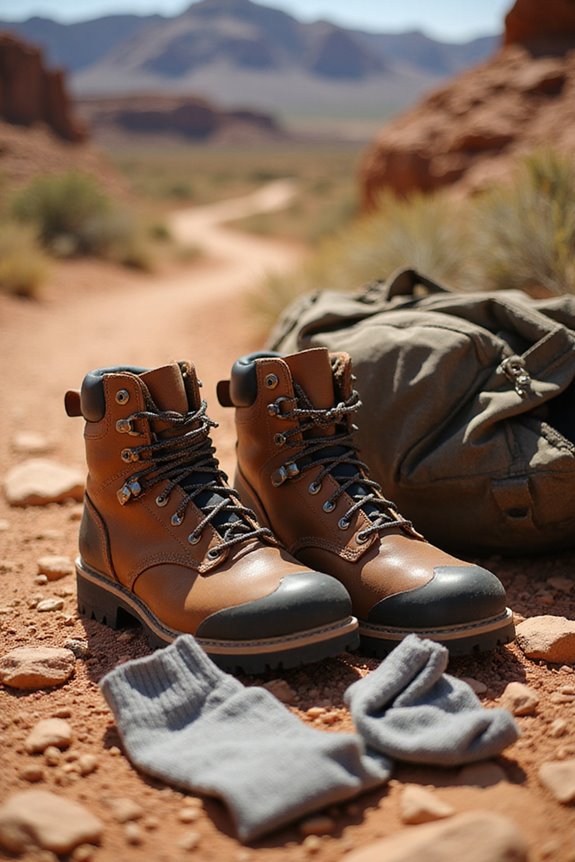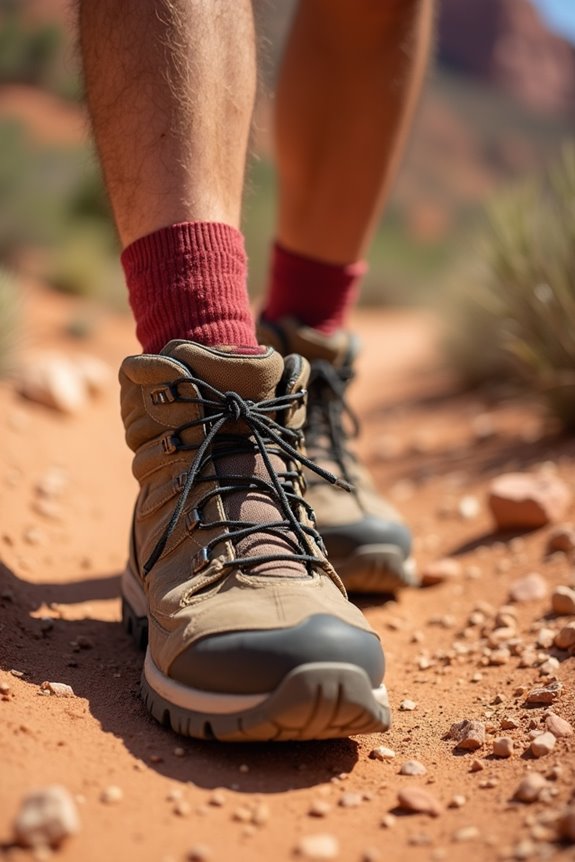When we talk about hiking boots, we’re not just choosing footwear; we’re gearing up for epic adventures! First, let’s pick the right material—think full-grain leather for toughness or lightweight synthetics for breezy trails. Fit’s vital; your toes need room, but your heels shouldn’t slip. Performance features like traction and cushioning can make or break your hike—trust us, we’ve learned the hard way! Stick around, and we’ll share more tips to guarantee your next trail is a blast!
Key Takeaways
- Choose the right material based on your hiking needs; full-grain leather offers durability, while synthetic materials provide lightweight comfort.
- Ensure a proper fit by leaving a finger’s width at the heel and testing with your preferred hiking socks.
- Look for boots with excellent traction and cushioning, such as Vibram outsoles and dual-density midsoles, for better comfort on diverse terrains.
- Maintain your boots’ durability by regularly cleaning, conditioning, and waterproofing them, avoiding harsh chemicals.
- Consider safety features like toe protection and ankle support for added stability to prevent injuries on uneven trails.
Choosing the Right Material
When we’re gearing up for those epic hiking adventures, choosing the right material for our boots is absolutely essential! Full-grain leather is tough, ideal for rugged trails, but it’s heavy and takes a while to break in. For those of us seeking a lighter option, split-grain leather mixed with nylon offers comfort and great breathability, though we might sacrifice some durability. Nubuck leather strikes a balance—it’s soft yet sturdy, perfect for versatile hikes. And let’s not forget synthetic materials! They’re lightweight and easy to break in, but they may not endure like leather. When making our material comparisons, let’s also consider ethical options, like vegan boots. Free your feet responsibly—you’re ready for the trails! Regular waterproofing treatments will extend the life of your boots regardless of material choice.
Ensuring a Proper Fit

Finding the perfect fit for our hiking boots is a game-changer for those epic outdoor escapades! First, we need a solid length assessment: there should be about one finger’s width between our heel and the boot’s rear when standing. Our toes should touch the front but still wiggle. Let’s not forget width adjustment; snug midfoot fit is key, but not too tight—pinching’s a no-go!
We’ll also want to guarantee heel security to dodge blisters while we tackle those uneven trails. It’s essential we test them with our favorite hiking socks for sock compatibility. Remember, our feet aren’t identical; let’s fit to the larger one and use proper lacing techniques for overall snugness. Many experts recommend ordering a size up when purchasing hiking boots to ensure proper toe box room and prevent discomfort on long treks. Let’s adventure on!
Evaluating Performance Features
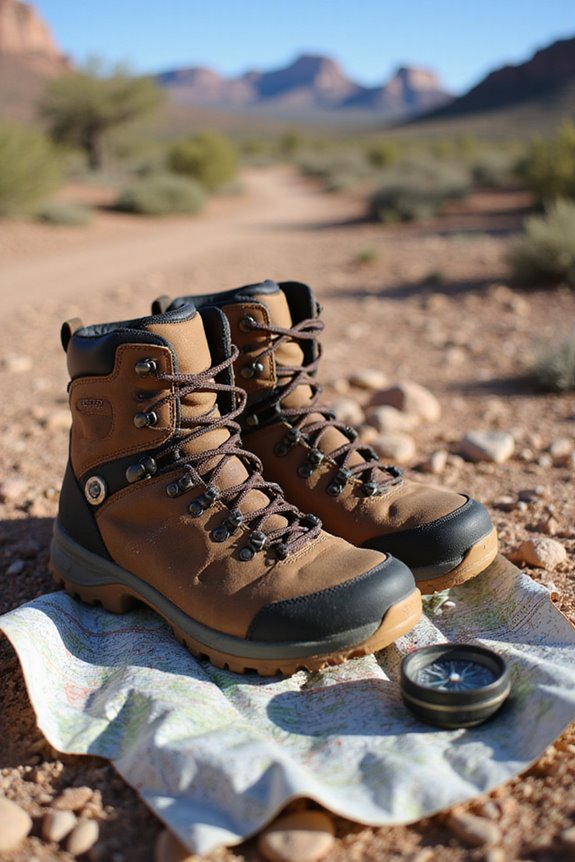
Choosing the right hiking boots means diving into the nitty-gritty of their performance features! Let’s kick things off with traction analysis; boots with Vibram outsoles and deep 4.9 mm lugs offer unbeatable grip on rocky or slippery trails. We need that stability so we don’t wobble like a newborn giraffe! Next up is cushioning assessment. Dual-density midsoles provide just the right balance—soft enough for comfort, firm enough for support. A stack height of around 39 mm keeps our feet from feeling every pebble while staying light. We’ll crush those long hikes without the dreaded hot spots or blisters. Multi-directional traction proves essential for navigating diverse terrains from muddy paths to steep rocky inclines. In the end, gear up for adventure; the right boots make all the difference on the trail!
Maximizing Durability
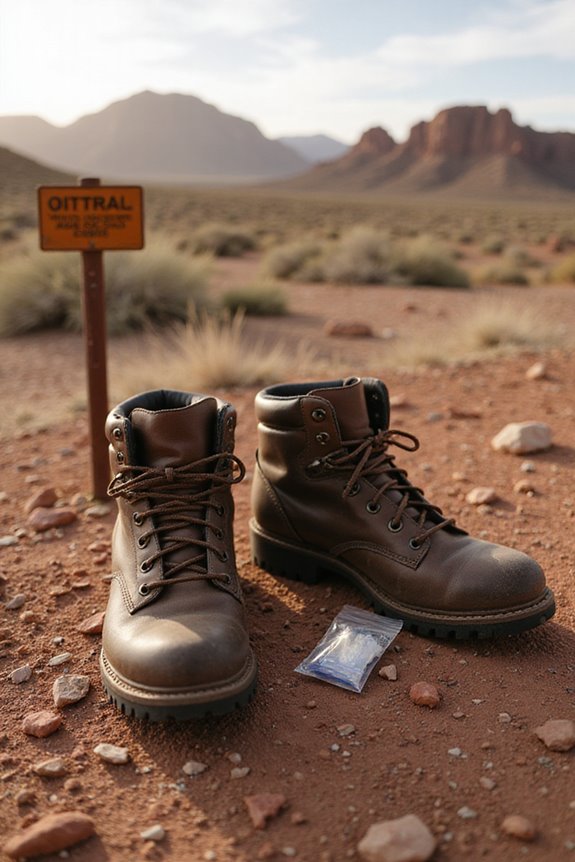
To guarantee our hiking boots go the distance, we need to give them the care they deserve! It’s not just about hitting the trails; it’s about adopting solid cleaning techniques and maintenance habits. After every adventure, let’s sweep away dirt and debris with a soft brush, protecting that precious leather. Rinsing off mud gently saves our seams from damage. We can avoid harsh chemicals that might strip natural oils, keeping our boots strong and flexible.
Monthly conditioning keeps our boots ready for action, while seasonal waterproofing enhances their resilience against unexpected weather. When it comes to drying, let’s do it naturally—no heat! Store them with care, and we’ll guarantee they’re always ready to roam freely! Applying a quality waterproofing spray regularly will extend your boots’ lifespan and maintain their ability to keep your feet dry during unpredictable weather conditions.
Incorporating Safety Features

When it comes to hitting the trails, we can’t overlook how incorporating safety features into our hiking boots can make all the difference! We all want to roam freely without the fear of stubbing our toes or twisting our ankles, right? That’s where solid toe protection and ankle support come in. Opting for composite toe boots not only keeps us safe from rocks but also means we’re lighter on our feet—who wouldn’t love that? Plus, high-cut boots provide the stability we need on uneven terrain, reducing the risk of sprains. Remember, safety features are our adventurous allies, helping us conquer longer hikes without sacrificing comfort. Boots with KEEN ALL-TERRAIN rubber outsoles offer exceptional traction to prevent slips on challenging trails. So let’s lace up those boots and embrace the wild with confidence!
Selecting Based on Terrain and Weather
Hitting the trails without the right boots is like trying to run a marathon in flip-flops—just don’t do it! When we’re out conquering rocky terrain, a stiff-soled boot with excellent traction levels is a must for tackling those sharp rocks. If we’re facing muddy trails, let’s grab boots with aggressive tread patterns and waterproof features to keep our grip and feet dry. Snow or ice? High-cut, insulated boots will save our ankles and keep us cozy! For those breezy days on well-groomed trails, lightweight shoes let us feel free and fast. Remember, the right boot type transforms our adventure, turning dodgy trails into thrilling escapades. Let’s lace up and hit the trail with confidence!
Frequently Asked Questions
How Do I Clean My Hiking Boots Effectively?
When we clean our hiking boots, we should follow effective boot cleaning techniques and maintenance tips. By removing laces, soaking, and using gentle cleaners, we can guarantee they’re ready for our next adventure.
When Should I Replace My Hiking Boots?
Like the changing seasons, our hiking boot lifespan needs careful observation. We should replace our boots when we see signs of wear or structural decline, ensuring our adventures remain as free and exhilarating as our spirits.
Are Waterproof Boots Always Necessary for Hiking?
Are waterproof boots always necessary for hiking? We think it depends on conditions. While waterproof features keep us dry, we shouldn’t overlook boot breathability; in dry weather, lighter options might offer the freedom we crave.
Can I Wear Regular Socks With My Hiking Boots?
Can we wear regular socks with our hiking boots? We wouldn’t recommend it. Hiking sock materials wick moisture, and the right sock thickness impacts comfort, preventing blisters and keeping our feet happy on the trail.
How Do I Break in New Hiking Boots?
Breaking in new hiking boots? Sure, let’s jump into some medieval torture methods—oh wait, just wear ‘em around the house! Our boots’ll adapt to various terrains, no need for drama, just comfort and adventure!

